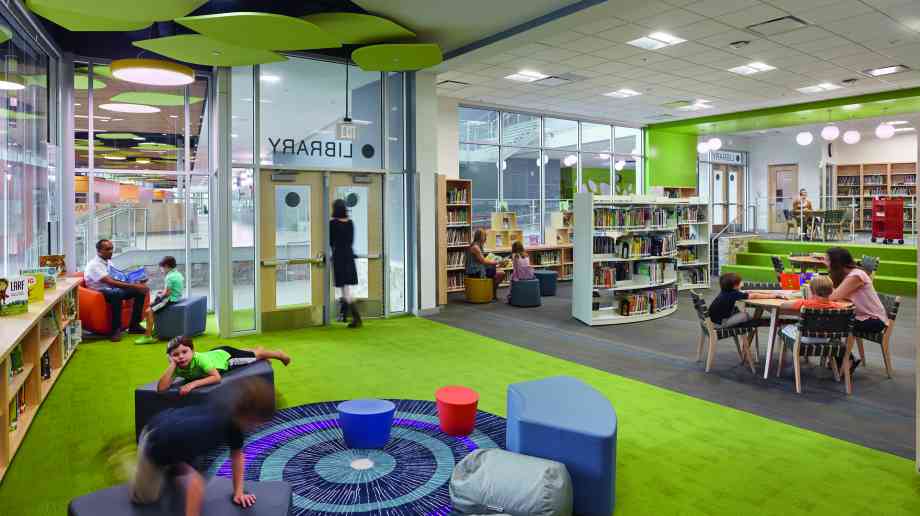
Designing schools with the community in mind
When schools are designed, planners must consider their potential use outside of school hours, as well as how parents and members of the community will interact with them, writes Irena Barker
The Longsight neighbourhood of Manchester is home to many immigrant families and often parents are new to English - which can make accessing services for their children difficult. Cultural norms also mean the youngest children do not always attend early years education.
So when Longsight Community Primary School was built in 2013, next to an existing children’s centre and nursery, executive headteacher Rukhsana Ahmed wanted it to become part of a “one-stop-shop” for the education and care of children aged 0 to 11.
As many parents spoke Urdu, Bangali and Arabic as a first language, reaching out to the community would be key to getting children into optional yet vital nursery education. An important step was creating a shared reception area which joined the new school with the existing children’s centre and nursery. They also now share a family room, meeting rooms and soft play.
“People can come in to our front entrance and we have receptionists who are very good at signposting each service. People know they can be supported whatever the age of their child,” says Ahmed.
A number of other community initiatives have added value across the school, including a volunteering scheme which has led to the recruitment of bilingual teaching assistants from the local community - boosting Longsight’s focus on communication and language.
Community engagement
Longsight and its “Family Hub” are clearly meeting the very specific needs of their local community – and reaping the rewards of valuing the talent around them. But it is not an easy thing to achieve, especially in secondary.
Government policies that have increased competition between schools and removed local authority oversight have meant schools are less likely to be automatically woven into their communities. School leaders now have to make it a priority. Increased safeguarding concerns too have led to schools being, inevitably, less open as fences are erected and gates locked. The funding squeeze too means that schools have fewer resources to invest in community engagement.
However, Terry White, chair of the Association for Learning Environments UK, says in his new book Planning Learning Spaces: “A school is not an educating island; it is part of the community, so should be used by the community. The vision, culture and leadership of the school must make explicit that the school is open, interactive, engaging and communicative, rather than closed, remote and inaccessible,” he writes.
When spaces are designed, he says, planners must consider their potential use outside of school hours, but also how parents and members of the community will interact with them during school hours.
One good example of this is the Gardens School in Auckland, New Zealand, which underwent a rebuild in 2016. The new design creates integrated spaces for pupils and community and a library open to the public. The spaces include homely touches such as soft seating and objects reflecting life and work in the local area.
Principal Susannah Fowler says: “The key aim is to ensure that there is a friendly, caring and family-orientated environment where parents are engaged and feel comfortable.”
But physically opening up learning spaces to reduce the “fortress” effect is just the start. White says: “Building community is not just about shared space but ensuring that inclusive approaches are in place to be able to respond equally to all interests, cultures and social groups.”
Embracing diversity
Indeed, at Queen Katherine Academy, a secondary school in Peterborough, Cambridgeshire, engagement with its incredibly diverse community has been vital to injecting vitality into the school, improving pupil motivation and boosting student numbers.
“For schools it’s really important that you have to get where the people are and get where the energy is – get where the emotions are,” says chair of governors Bernard Barker. The academy has used public performances, especially in drama and music – drawing on pupils’ interests and cultures – to attract families into the school. It is also involved in schemes to engage and give opportunities to Roma children and their families. Around 30 per cent of students are from such backgrounds, with many recently arrived from Eastern Europe. “When you are dealing with a delicate, inward-looking community like that, to progressively involve them in activities that treat them as valued people is terribly important,” says Mr Barker.
The place to be
Even renting out spaces to community groups can have an impact beyond the financial, he says. “Everything that makes the school a place where things happen draws people in, gives them opportunities and increases the inner dynamism. A school which is sat on it’s own private hill taking exams serves no purpose,” he believes. Primary liaison work has been key as well, and pupils from local primaries come in for workshops and competitions in different subject areas. “You’re building the confidence in the primary schools which are closer to their communities than we are,” he says.
But Barker stresses the school is not just engaging with the community, it is creating it. Many pupils come from all corners of the city, and many are from migrant families. “Here we’ve really got an international community, it just happens to be based in Peterborough. But a good school makes its community.”
A community resource
At Oxford Academy, a school in a deprived area of Oxford, community engagement has been at the core of their mission from the start. Headteacher Andy Hardy writes on the school’s website: “The building was designed in partnership with students, parents, carers, local residents and our stakeholders to ensure it can be used as a community resource for the local area for many years to come.”
The school offers an array of facilities for use by local sports clubs, businesses and charities and an education programme created in partnership with members of the community. Maths and English GCSE and ESOL classes are offered free as part of a priority to improve literacy and numeracy in the area. There are also opportunities for local people to volunteer in the school, including staff and students from local universities.
Hailey Dunn, business leadership specialist at the Association of School and College Leaders stressed that a lot of thought and detailed planning must go into any mission to open up a school for community use. She highlights considerations such as vetting, insurance, caretaking, cleaning, parking and accessibility, site security and access, and even PFI arrangements could be affected.
Stuart Gallimore, immediate past president of the Association of Directors of Children’s Service and director of children’s services in East Sussex, is upbeat about schools’ capacity to engage with communities and meet their needs. But it only happen if schools prioritise it, he says. “It’s like most things, where there’s a will there’s a way. You can always point to those schools that are really inclusive of the community and you can point to those schools where that’s less important to them.”
But he stressed it was an “over simplification” to say that local authority-run community schools are inevitably doing more than academies. Schools of different types, he says, are identifying community needs and endeavouring to meet them.
“Competition between schools and the focus on results and attainment need not be a barrier to community engagement,” he adds, “It doesn’t have to be either/or.”
Planning Learning Spaces: A Practical Guide for Architects, Designers and School Leaders by Murray Hudson and Terry White is published by Laurence King. Available at all good bookstores and at laurenceking,com, RRP £24.99.
Latest News
26/09/2025 - 11:08
Three schools have been fitted with solar panels over the summer as part of a government-funded scheme, with eight more schools set to get their solar panels this autumn.
25/09/2025 - 09:51
Charity Speech and Language UK has published its whitepaper in lieu of the delays to the government’s own Schools White Paper – delays which are damaging children’s education, mental health and future.
25/09/2025 - 09:34
The scheme will see high-achieving young people from disadvantaged areas receive letters from students at Kings College London, encouraging them to consider a university education.
24/09/2025 - 10:22
A coalition of over 60 leading organisations from the UK’s creative and digital industries, alongside education experts, are calling on the government to introduce a new Digital Creativity GCSE.
24/09/2025 - 09:59
The Government’s Youth Hub programme – which are hosted by sports clubs and other community venues, will almost double in number thanks to £25 million new investment.







